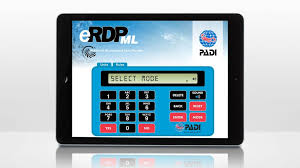Open Water Dive Theory Section 5: “Plan Your Dive, Dive Your Plan”
Congratulations on reaching the final section of the Amadive Open Water theory series! You have the foundational knowledge from Sections 1 through 4, and now it’s time to put it all together to become an autonomous and responsible diver.
This is the most critical part, where theory turns into action. We will learn how to plan a dive from start to finish, use modern tools, and adhere to the mantra of every safe diver: “Plan your dive, and dive your plan.”

1. Your Tools: Dive Computers and Dive Tables
To dive safely, you need tools to track your time and depth, which are used to calculate your nitrogen absorption.
- Dive Tables (Recreational Dive Planner – RDP): This is the traditional tool, a plastic table that helps you determine the maximum time you can spend at a certain depth without requiring mandatory decompression stops. While less common today, understanding its principles is still valuable.
- Dive Computer: This is the modern standard. It’s a wrist-worn device that tracks your depth and time in real-time.
- Advantages: It provides precise and flexible information, automatically calculates your no-decompression limits, monitors your ascent rate, and logs your dives. This is the most important piece of safety equipment you should own.
2. Core Concepts in Dive Planning
Regardless of the tool you use, you need to understand these concepts.
- No-Decompression Limit (NDL): This is the maximum amount of time you can stay at a specific depth and still be able to ascend directly to the surface (with a safety stop) without needing complex decompression stops. Exceeding this limit significantly increases your risk of decompression sickness (DCS).
- Safety Stop: This is a stop that should be performed on every dive, typically at 5 meters (15 feet) for 3 minutes before ending the dive. It gives your body extra time to safely off-gas nitrogen.
- Repetitive Dives: When you make more than one dive in a day, your body still has residual nitrogen. A dive computer automatically calculates this to give you shorter time limits for subsequent dives.
- Ascent Rate: Always ascend slowly, never faster than your dive computer indicates (usually around 9-10 meters or 30 feet per minute).
3. Steps to a Safe Dive Plan
- Discuss With Your Buddy: Before entering the water, agree on: maximum depth, planned bottom time, and the objective of the dive (e.g., photography, observing coral).
- Check Your Limits: Based on your plan, consult your dive computer or tables to ensure you have plenty of no-decompression time.
- Plan Your Air: Agree on a turnaround pressure (e.g., turn the dive when you reach 100 bar / 1500 PSI) and a minimum ascent pressure (e.g., be back on the boat with 50 bar / 700 PSI).
- Consider Environmental Conditions: Apply your knowledge from Section 3 to assess currents, visibility, and other factors.
- Review Emergency Procedures: Quickly discuss how to handle situations like buddy separation or an out-of-air emergency.
Conclusion: You Are Ready!
Completing these 5 theory sections means you haven’t just learned how to dive, you’ve learned how to think like a diver. You have the knowledge to keep yourself and your buddy safe, to respect the marine environment, and to plan your own incredible adventures.
This knowledge is your passport to the other 70% of our planet. Be proud of what you have learned!
Your Journey is Just Beginning
The Open Water Diver certification isn’t the end; it’s a “license to learn.” The ocean still holds countless wonders waiting for you at greater depths and in more challenging conditions. Once you are confident with the basic skills, the next step on the path of a diver is the Advanced Open Water course.
This course isn’t about teaching you “super-advanced” techniques, but rather about letting you experience different types of diving under the guidance of an experienced instructor, thereby enhancing your skills and confidence.
Are you ready for the next challenge?
➡️ Explore our Comprehensive Guide to Advanced Open Water Dive Theory to see what awaits.
